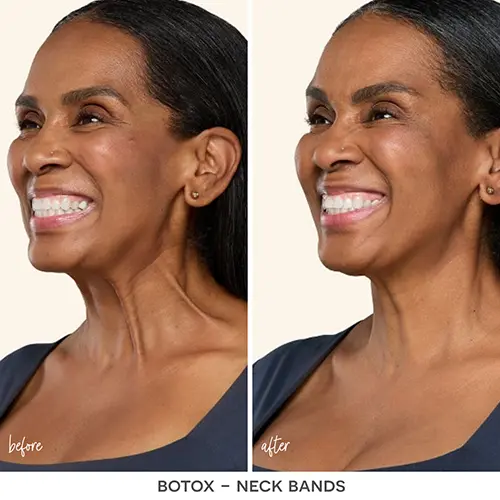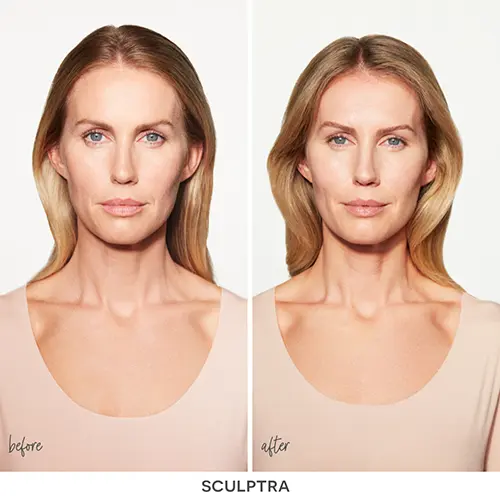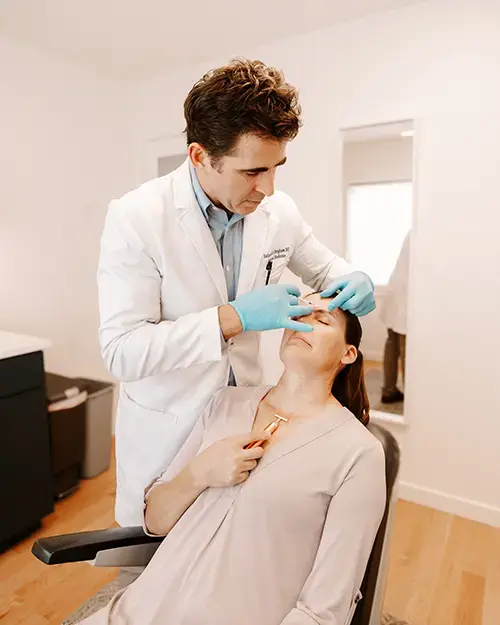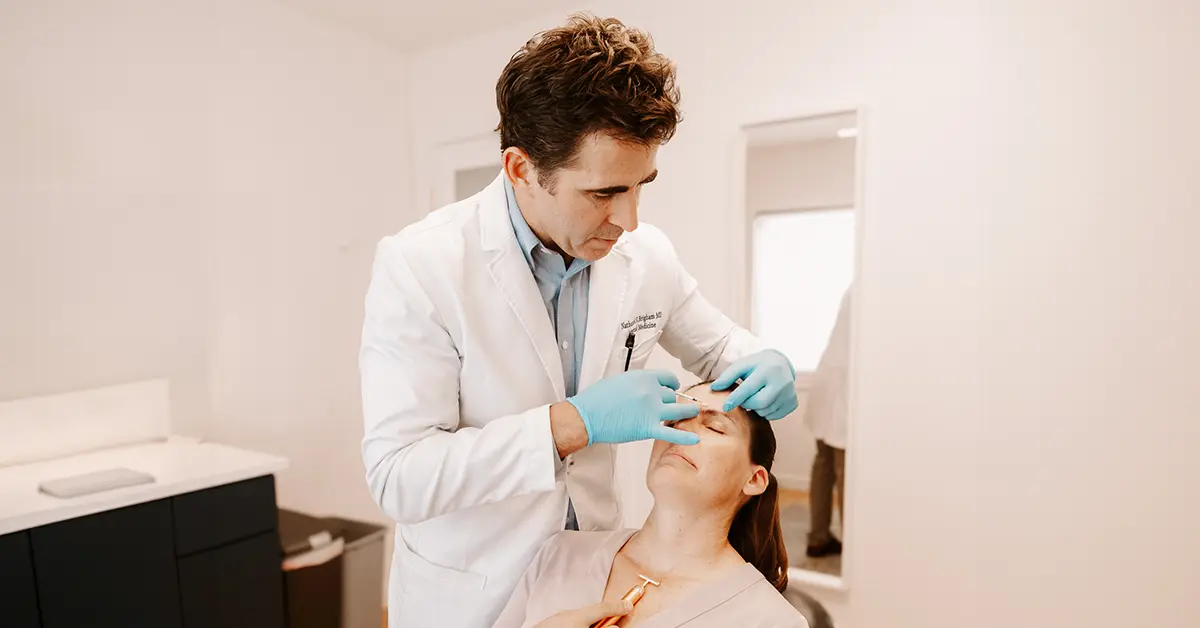What hasn’t changed, however, is Dr. Nathaniel Brigham’s signature approach to aesthetics at Aluma Aesthetic Medicine: natural, effortless results and treatments that fit seamlessly into real life. As we move into 2026, Portland’s medical aesthetic patients are focusing on prevention, subtle enhancements, and using skilled local injectors who appreciate an “understated glow.”
In this guide, we’ll explore top injectable treatments shaping the year ahead, the aesthetic trends defining Portland’s look, and how to choose the right provider to help you reach your goals with confidence and authenticity.
A Look Back: 2025’s Most Popular Injectable Treatments
Botox Continues to be Portland’s Most Popular Treatment

Over the past few years, we’ve seen a significant shift in how people talk about Botox — and we love it. What used to be a “secret” is now openly discussed among friends, coworkers, and even at the gym. And it should be. Botox isn’t fake, indulgent, or something to hide; it’s a prescription medication with a clinically proven purpose: to relax the muscles that create wrinkles. No serum, no matter the price tag, can do what Botox does for wrinkles, not yet anyway. So, save your money and skip the $300 creams if you are on a budget, and opt for a prescription injectable wrinkle relaxer.
Botox works by gently relaxing specific facial muscles to soften lines and prevent deeper creasing over time. It’s easy to see why Portlanders love it—treatments are quick, downtime is minimal, and results typically last three to four months, depending on dosage. While more units can extend longevity, the art lies in balance: too many units, especially in the forehead rows, can lead to a heavy feeling or a shiny forehead.
For a full-face refresh that looks lifted and smooth, many are now choosing Botox treatments for the lower face and neck. By addressing vertical neck bands and their connection points along the jawline, we can create a subtle lift, soften downturned corners of the mouth, and refine jawline definition by relaxing the muscles that pull it downward. And with Botox receiving FDA approval for this area just this year, it has quickly become a highly requested treatment option.
Sculptra Outpaced Dermal Fillers This Year

Portland loves its trees, its vegan restaurants, and, more recently, Sculptra. At Aluma Aesthetic Medicine, located on Portland’s east side, we have seen a noticeable uptick in Sculptra treatments among patients seeking more natural-looking results with subtle yet long-lasting effects. Sculptra works by stimulating resident fibroblasts to produce autologous collagen over time, resulting in a more natural and long-lasting effect 1. Its main ingredient, poly-L-lactic acid (PLLA), stimulates collagen formation through the body’s inflammatory response to this biocompatible substance. Over time, the PLLA particles are metabolized and oxidized into carbon dioxide 2. Within about six months, the initial inflammatory response subsides, but the extracellular matrix continues to strengthen, resulting in increased dermal thickness that can last for 2 years or more 1.
Sculptra tightens, brightens, and subtly lifts the skin due to increased collagen and elastin production driven by fibroblast activity. Collagen, a fibrous protein that maintains skin structure and firmness, naturally decreases with age. By age 40, most people have lost around 20 percent of their collagen 2. Sculptra brings it back and also promotes higher levels of hyaluronic acid within the skin’s cellular matrix, contributing to what many refer to as the “Sculptra glow.”
A general rule of thumb many providers use is “one vial of Sculptra per decade of age.” So a 50-year-old would need about five vials total, spread over 2 to 3 treatments. In practice, that often translates to 2 vials at the first session, followed by 1 to 3 additional vials depending on factors such as skin quality, volume loss, and the patient’s goals. For maintenance, many providers recommend one vial every year to help sustain collagen stimulation.
While Sculptra excels at improving skin quality and global facial support, it does not contour or replace deep structural volume the way traditional fillers can. For this reason, dermal fillers remain essential tools for sculpting the cheeks, re-volumizing temples, and contouring the jawline, often yielding the most natural and beautiful results when combined with Sculptra.
Natural-Looking Lip Filler Is the New Standard
A natural-looking lip refresh never goes out of style, which is why lip filler remains one of the most requested treatments at Aluma Aesthetic Medicine. As we age, reduced lip volume can contribute to common concerns such as vertical “smoker’s lines,” dryness, marionette lines, and a less defined cupid’s bow. Dermal fillers offer a minimally invasive solution to restore lip volume, shape, and definition, something topical products and most surgical approaches cannot achieve on their own.
In 2026, the aesthetic trend will continue to favor subtle, balanced lip enhancement rather than the exaggerated looks that once dominated social media. While many “before and after” images online still show overly filled or disproportionate results, this no longer reflects the work of skilled, modern aesthetic providers. As filler technology and techniques evolve, today’s approach to lip filler is more refined, focusing on harmony, proportion, and the enhancement of a patient’s natural features.
Beyond simply restoring volume, lip filler can also rejuvenate the surrounding mouth area in ways patients often do not expect. Strategically placed filler can gently lift the corners of the mouth, soften marionette lines, and smooth vertical “smoker’s lines” for a smoother transition and more balanced appearance overall 7. These techniques address subtle age-related changes in the lip region and create restorative, natural-looking results. When performed by an experienced aesthetic provider who understands anatomy, proportion, and restraint, lip augmentation can enhance your natural beauty without ever appearing “done.”
Why Full-Face Balance Is Redefining Portland Aesthetics in 2026

Portland has always embraced a natural, effortless look, and that mindset continues to shape the way our patients approach cosmetic treatments. Instead of dramatic changes, people are seeking full-face balance, subtle refinement, and results that look like “you, but rested.” A growing trend among patients age 40 and older is shifting away from treating one isolated area and instead focusing on harmonizing the entire face through a thoughtful combination of dermal fillers, collagen stimulators, and neuromodulators. The goal is a refreshed, lifted appearance that feels completely authentic.
One of the most overlooked yet highly effective areas in this approach is temple filler. As we age, we lose volume not only in the cheeks and under-eyes but also in the temples, which can create a hollowed look that disrupts facial balance. This is especially true when inexperienced providers focus solely on the cheekbone area. Restoring temple volume smooths the transition between the forehead, the outer eyebrow, and the cheek, which is essential for facial harmony. This treatment can also lift and lengthen the tail of the eyebrow, further enhancing upper facial aesthetics 8. Temple support is one of the best examples of how small, targeted corrections can create meaningful improvements in overall balance.
Another often under-treated yet high-impact area is the jawline. Many women worry that adding dermal filler here will create heaviness or a more masculine appearance. In reality, when performed with an understanding of facial harmony, jawline filler can have a pinning back and lifting effect on the jowls. A 2024 study showed that jawline filler alone produced a statistically significant improvement in jowl severity, independent of cheek filler, with both patients and blinded reviewers reporting high satisfaction. This benefit is largely attributed to the restoration of mandibular support, which helps counteract soft-tissue descent and jowl formation 9.
As we look back on 2025, it is clear that the Portland aesthetic mindset of subtle volume and natural refinement has dominated. Looking ahead to 2026, treatments such as temple filler and jawline contouring will become central elements of balanced, age-aware rejuvenation strategies. We also expect continued growth in regenerative injectables such as Sculptra, along with an increased use of combination treatment plans that layer neuromodulators, dermal fillers, and collagen stimulators for optimal results. In short, 2026 will be a year of intelligent, natural rejuvenation that aligns perfectly with the Portland ethos.
Choosing an Aeshetic Medicine Provider
Experience & Number
of Injections
"How many years have you been performing injections, and how often do you treat this specific area?"
Complication Management &
Safety Protocols
"What is your protocol if a complication occurs, and how often have you managed these situations?"
Ongoing Training &
Technique Evolution
"What recent trainings or advanced workshops have you completed, and why do you prefer the products you use?"
Natural Results Philosophy &
Volume Discipline
"How do you determine the amount of product needed to achieve natural and balanced results?"
Local Boutique Practice vs.
Big Chain Clinics
“Will I see the same injector each visit, and how do you manage long-term follow-up?”
Transparent Pricing, Reviews &
Ethical Standards
“Can we go over pricing, maintenance expectations, and your follow-up support after treatment?”

Works Cited
Readable, public-facing citations formatted for web accessibility.
- Bohner, K., Dorizas, A. M., Lorenc, P., Sadick, M.
Randomized, Controlled, Multicentered, Double-Blind Investigation of Injectable Poly-L-Lactic Acid for Improving Skin Quality.
Dermatologic Surgery, 2019; 45:718–724. - Onesti, M. G., Monarca, C., Rizzo, M. I., Mazzocchi, M., et al.
Minimally Invasive Combined Treatment for Parry-Romberg Syndrome.
Aesthetic Plastic Surgery, 2009; 33:452–456. - Augmentation Fillers.
In Approach to Choosing the Ideal Filler. Cambridge University Press, 2010. pp. 5–12. - Ahmad, R.
A Comprehensive Evaluation of Dermal Fillers in Aesthetic Medicine: Safety, Efficacy, and Long-Term Outcomes.
Journal of Pharmacology, 2025. - Kalia, E., Allémann, L., Jordan, O.
Clinical Perspectives on the Injectability of Cross-Linked Hyaluronic Acid Dermal Fillers: A Standardized Methodology for Commercial Product Benchmarking with Inter-Injector Assessments.
Gels, 10(2):101. - Yamasaki, A., Lee, L. N.
Facial Fillers in Lip Reconstruction.
Operative Techniques in Otolaryngology–Head and Neck Surgery, 2020; 31:38–44. - Hong, C., Choi, Y., Yoon, W., Yee.
Anatomical-Based Diagnosis and Filler Injection Techniques: Lips and Philtrum.
Life, 2025; 15(2). - Rose, A. E., Day, D.
Esthetic Rejuvenation of the Temple.
Clinics in Plastic Surgery, 2013; 40(1):77–89. - Taub, A. F., Callender, V. D.
Jowl Improvement With Injectable Fillers: Jawline Injections Alone Versus Jawline and Cheek Injections.
Dermatologic Surgery, 2024; 50.

